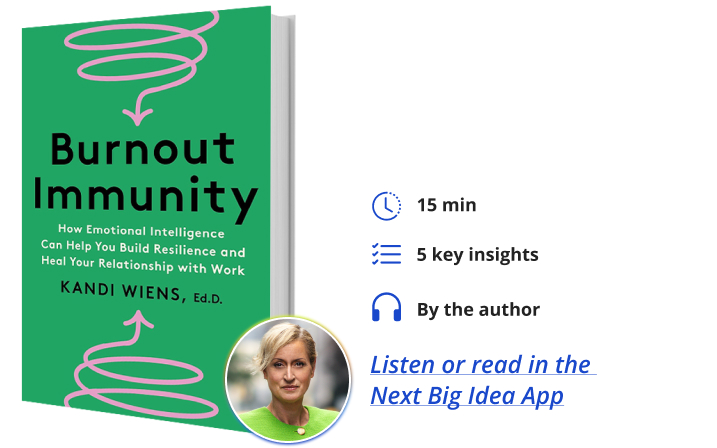Kandi Wiens is a senior fellow at the University of Pennsylvania, the director of the Penn Master’s in Medical Education Program and the Penn Health Professions Education Certificate Program, and the academic director of the PennCLO Master’s Program. She is also a member of the Thinkers50 Radar 2024 cohort, a researcher, a national speaker, and an executive coach.
Below, Kandi shares five key insights from her new book, Burnout Immunity: How Emotional Intelligence Can Help You Build Resilience and Heal Your Relationship with Work. Listen to the audio version—read by Kandi herself—in the Next Big Idea App.

1. Use your awareness of your emotional response to stress.
This includes taking a close look at how you typically respond to stress—what we call Protective Patterns—and how those are working for or against you. It also includes enhancing your awareness of how your emotions drive your thoughts and your behaviors when you are stressed. Greater awareness will enable you to learn several important things about yourself. What motivates you? What excites you about different aspects of your work? What ticks you off or what triggers you? And why do things trigger you?
Awareness also includes learning about what makes you more sensitive to stress and what puts you over the tipping point from good stress—which gives you energy and focus—to bad stress that depletes and overwhelms you. You can also discover your protective patterns under stress, the impact you have on colleagues and culture when you’re stressed, and what you can control and what you can’t.
Awareness is the foundation upon which all the other Burnout Immunity skills are built.
2. Use your regulation skills to manage your emotions, thoughts, and behaviors.
Especially when stressed out, overwhelmed, or dysregulated, our emotions can gain the upper hand, and our thoughts can spiral out of control. We all know what happens when we’re in an agitated state. We often act in ways that aren’t productive or are even downright harmful, which ends up stressing us (and our colleagues) out even more. Learning and applying self-regulation skills will help prevent you from succumbing to negative thoughts, unproductive emotions, and impulsive, unexamined behaviors that put you at risk of burnout and that can distract you from your vision of your ideal self.
From my research, I’ve found that people with burnout immunity use their regulation skills to stay in control of their emotions, even in the midst of high-stress situations. They do this by practicing three essential strategies.
“Perhaps most important of all, they are able to tolerate negative emotions without reacting impulsively.”
First, people with burnout immunity view stressors as problems that can be solved. That doesn’t mean they don’t have an emotional response to stress. But they don’t get hijacked by the emotions. They can effectively control their emotions and turn their attention to working their way through or around the stressor.
People with burnout immunity also proactively manage their emotional investment in work. They don’t get caught up in pleasing other people. They limit their time and interactions with coworkers who are energy vampires or who have a negative or cynical attitude about work. They enact firm boundaries around work, and they create and uphold emotional boundaries as well. They try not to take things too personally. They proactively counteract negative emotional experiences with positive ones.
Finally, people with burnout immunity practice adaptive emotional regulation. They are able to label and understand their emotions. They understand what triggers their emotional reaction to stress. As well as the underlying reasons for why they are triggered by certain things or people. Perhaps most important of all, they are able to tolerate negative emotions without reacting impulsively.
3. Use your Meaningful Connections to stay grounded in what’s most important to you.
Connecting to people, places, and experiences that bring you joy and help you feel the most authentic version of you is one of the best antidotes to stress. Research shows that people who have meaningful connections of any type enjoy greater well-being, less stress, and are more physically and emotionally healthy. These connections could be with their personal or community relationships, their jobs or sense of mission, their goals, or their hobbies and passion projects.
4. Apply your mindset to achieve burnout immunity.
Mindset has to do with our general beliefs and attitude about work, life, and everything in between.
Think about this for a second: Do you come from a hopeful, optimistic orientation or a more negative and pessimistic one? Do you believe that the world is a place that is delightful, beautiful, safe, abundant, full of meaning, and capable of getting better? Or are you convinced that everything is going to hell in a handbasket?
“People with the strongest natural burnout immunity are those with the most positive outlooks.”
Research attests that people with a positive, hopeful outlook and who believe they can effect positive change are more resilient, less stressed, and have better personal and professional relationships. This is the case even if their personal or outer circumstances are very negative. In my own research, people with the strongest natural burnout immunity are those with the most positive outlooks, those who believe that stress can be enhancing, those who have a servant leadership mindset, and those who practice regular self-compassion.
5. Healing from burnout requires a 3Rx prescription.
The three R’s stand for recover, reconnect, and reimagine. It is a burnout immunity strategy unto itself. People who engage in regular recovery from work stress lower their risk of burning out. And certainly, adequate recovery and healing time is needed most once we’re in an active state of burnout. An emergency medicine physician once told me that her real healing journey didn’t begin until she was able to leave the place that was making her sick.
People who periodically take time to reconnect with their values and vision, especially when they’re grappling with major stressors at work—a new role, a change in company culture, or a setback—are better equipped to avoid burnout.
Finally, people who can reimagine a new way forward are empowered to move beyond the stress they’re currently feeling. Whether after burnout has struck or when they first notice stress escalating, they can tame the flames of burnout.
Working on achieving burnout immunity is not easy work, especially if you’re burned out or at high risk of burnout or if you’re engaging in a lot of deep self-reflection and perhaps facing some painful realities for the first time. But trust me, it is all worth it. Once I was able to break myself free from burnout using the strategies I learned from my research participants, I freed myself to focus on the good stuff, the stuff that makes life meaningful, joyful, and beautiful.
To listen to the audio version read by author Kandi Wiens, download the Next Big Idea App today:





























